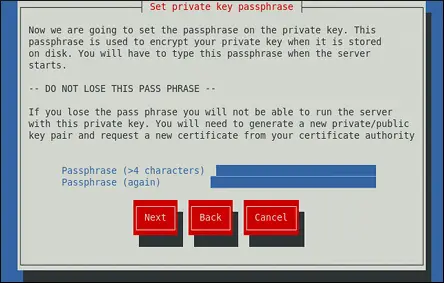Linux Generate Private Key Ssl
- Apr 09, 2020 Generate a server private key using a utility (OpenSSL, cfssl etc) Create a CSR using the server private key. Generate the server certificate using CA key, CA cert and Server CSR.
- Jul 09, 2019 Linux-based Operating Systems and web-servers (Apache, NGINX, LightHttpd) Normally, the CSR/RSA private key pairs on Linux-based operating systems are generated using the OpenSSL cryptographic engine and saved as files with “.key” or “.pem” extensions on the server.
How to Generate & Use Private Keys using OpenSSL's Command Line Tool These commands generate and use private keys in unencrypted binary (not Base64 “PEM”) PKCS#8 format. The PKCS#8 format is used here because it is the most interoperable format when dealing with software that isn't based on OpenSSL.
CSR stands for ‘Certificate Signing Request’, that is generated on the server where the certificate will be used on. A CSR contains information about to your organization and domain name, locality, and country and a public key that will be included in your certificate.
This article has 3 methods to create CSR (Certificate Signing Request) on Linux systems. You can choose any one of below methods. All methods will do the same task, only they have a detailed explanation.
Method 1 – Using Single Command
We can create CSR using the single command like below. But make sure you have installed OpenSSL package on your system. The below command will first create a private key and then generate CSR. This command will also require few details as input.
Method 2 – Short Instructions
Below are three simple commands to generate CSR. You may also use detailed instructions to do it.
Method 3 – Detailed Instructions
Step 1: Install Required Packages.
In order to generate CSR, you required OpenSSL to be installed on your system. If it is not already installed use below command to install it.
Step 2: Generate Key for your Domain.
Firstly you required root access to generate a key file. So login as root and use below command to generate a key.

Sample output:
At the end of the command, it showing 2048, which is the length of the key in bits. Most of CA required 2048 bit length keys. Above command will create a key file tecadmin.net.key, which is used in step 3.
Generate Ssl Private Key
Step 3: Generate CSR for your Domain using Key.
After generating a key, next steps are to generate CSR for the domain. Use below command to generate CSR file, This command will prompt for your organization and common name, locality, email, and country. Common Name must be the same as your domain name.
Sample Output:
Above command will generate a file
Windows Generate Ssl Key
References:
Public Private Key Encryption
http://wiki.centos.org/HowTos/Https
http://www.centos.org/docs/4/4.5/System_Administration_Guide/Apache_HTTP_Secure_Server_Configuration-Generating_a_Key.html